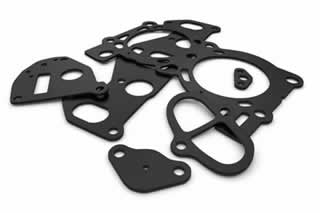
Not all machines consist of a single part. Many machines have dozens or even hundreds of parts. To prevent leaks around the surfaces where these parts meet, gaskets are used. Gaskets create a sealed mating surface between two or more parts. Once installed, they seal the parts together so that any gases or fluids flowing through the parts won’t leak.
What Is a Gasket?
A gasket is a fitted mechanical seal that’s designed to seal the surfaces where two or more parts are joined. Even if two parts of a machine sit flush with each other, they won’t offer a sealed environment. A micro-sized gap will separate them, which may prove problamtic if they contain a pressurized gas or liquid. When under pressure, gas or liquid flowing through the parts may escape around the unsealed mating surface.
Automotive engines, for example, consist of two main parts: a cylinder head and a block. Pressurized coolant and oil flow through the cylinder head and block. To prevent leakages around the mating surface of these two parts, a gasket is used. Known as a head gasket, it sits between the cylinder head and the block. Even as the coolant and oil become pressurized, the mating surface where the cylinder head meets the block won’t leak. If the engine doesn’t have a head gasket — or if the head gasket fails — coolant and oil will leak around the area between the cylinder head and block.
How Gaskets Work
Gaskets work by creating and maintaining a sealed mating surface under compressive loads. They are typically designed to withstand a maximum amount of pressure, which is reflected in their pounds-per-square (PSI) rating. As long as the pressure to which a gasket is exposed is under this rating, it will create a sealed and leak-proof mating surface.
Gaskets are able to create a sealed mating surface because they are made of pressure-resistant materials. These materials can withstand pressure while providing an air-tight seal in the process.
Gaskets are made of a variety of materials, some of which include the following:
- Stainless steel
- Copper
- Fiberglass
- Rubber
- Silicone
- Cork
- Polytetrafluoroethylene (PTFE)
For a gasket to function as intended, it must be designed to fit the mating surfaces with which it will be used. Most machine parts are flat on the ends where they are joined with other parts. If a part is a hollow passage for pressurized gases or liquids, though, a custom-sized gasket may be required to fit around the passage.
